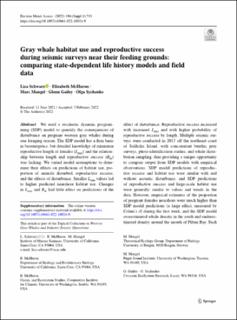| dc.contributor.author | Schwarz, Lisa | |
| dc.contributor.author | McHuron, Elizabeth | |
| dc.contributor.author | Mangel, Marc | |
| dc.contributor.author | Gailey, Glenn | |
| dc.contributor.author | Sychenko, Olga | |
| dc.date.accessioned | 2022-12-19T08:59:58Z | |
| dc.date.available | 2022-12-19T08:59:58Z | |
| dc.date.created | 2022-11-10T11:40:47Z | |
| dc.date.issued | 2022 | |
| dc.identifier.issn | 0167-6369 | |
| dc.identifier.uri | https://hdl.handle.net/11250/3038398 | |
| dc.description.abstract | We used a stochastic dynamic programming (SDP) model to quantify the consequences of disturbance on pregnant western gray whales during one foraging season. The SDP model has a firm basis in bioenergetics, but detailed knowledge of minimum reproductive length of females (Lmin) and the relationship between length and reproductive success (Rfit) was lacking. We varied model assumptions to determine their effects on predictions of habitat use, proportion of animals disturbed, reproductive success, and the effects of disturbance. Smaller Lmin values led to higher predicted nearshore habitat use. Changes in Lmin and Rfit had little effect on predictions of the effect of disturbance. Reproductive success increased with increased Lmin and with higher probability of reproductive success by length. Multiple seismic surveys were conducted in 2015 off the northeast coast of Sakhalin Island, with concomitant benthic prey surveys, photo-identification studies, and whale distribution sampling, thus providing a unique opportunity to compare output from SDP models with empirical observations. SDP model predictions of reproductive success and habitat use were similar with and without acoustic disturbance, and SDP predictions of reproductive success and large-scale habitat use were generally similar to values and trends in the data. However, empirical estimates of the proportion of pregnant females nearshore were much higher than SDP model predictions (a large effect, measured by Cohen’s d) during the first week, and the SDP model overestimated whale density in the south and underestimated density around the mouth of Piltun Bay. Such differences in nearshore habitat use would not affect SDP predictions of reproductive success or survival under the current seismic air gun disturbance scenario. | en_US |
| dc.language.iso | eng | en_US |
| dc.publisher | Springer | en_US |
| dc.rights | Navngivelse 4.0 Internasjonal | * |
| dc.rights.uri | http://creativecommons.org/licenses/by/4.0/deed.no | * |
| dc.title | Gray whale habitat use and reproductive success during seismic surveys near their feeding grounds: comparing state-dependent life history models and field data | en_US |
| dc.type | Journal article | en_US |
| dc.type | Peer reviewed | en_US |
| dc.description.version | publishedVersion | en_US |
| dc.rights.holder | Copyright 2022 The Author(s) | en_US |
| dc.source.articlenumber | 733 | en_US |
| cristin.ispublished | true | |
| cristin.fulltext | original | |
| cristin.qualitycode | 1 | |
| dc.identifier.doi | 10.1007/s10661-022-10024-9 | |
| dc.identifier.cristin | 2071733 | |
| dc.source.journal | Environmental Monitoring & Assessment | en_US |
| dc.identifier.citation | Environmental Monitoring & Assessment. 2022, 194, 733. | en_US |
| dc.source.volume | 194 | en_US |

